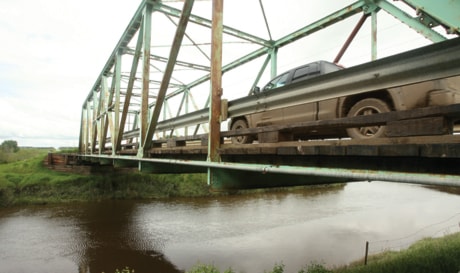Cool, fresh water is a hot commodity in Alberta.
So much so, in fact, that thirsty municipalities, industry and farmers in need of more water must rely on other users who have water rights to spare.
Faced with their own water surplus, a Calgary-based oil and natural gas company has applied to the Government of Alberta, who manages all water sources across Wild Ross Country, to donate half of its Medicine River licence to a conservation group.
The Medicine River begins west of Rimbey and ultimately flows into the Red Deer River southwest of the City of Red Deer.
In the landmark application, the first of it’s kind in Alberta, ConocoPhillips Canada requested to transfer 50 per cent of its allotment, or roughly 120 million litres of water a year, to the Water Conservation Trust of Canada that will protect the water from future use.
“The benefit would be securing a certain portion of that river’s flow for its natural functions,” said Lloyd Visser, vice president of environment and sustainable development with ConocoPhillips.
“The novel application here is the consideration of it going to a water trust rather than just turning it back in for another industrial use.”
In 2006, the provincial government declared a new moratorium on water licences.
The move saw the Tories stop accepting applications for new water licences in the over-tapped Bow River, Oldman River and South Saskatchewan River Basin and instead start accepting applications to transfer water licences.
When one user trades its excess water rights, a result of conservation efforts, a different user is able to utilize a particular stream for uses that range from irrigation to a cooling water plant.
Since 1968, ConocoPhillips has held a licence to draw water out of the Medicine River at Eckville to use in their operations.
But now that the oil field has matured, as Visser explained, it has been able to produce more water on its own. As a result, the company doesn’t need to divert as much freshwater out of the Medicine River to help with extraction.
Visser said they, therefore, decided to take advantage of the new licence regulations and filed an application to Alberta Environment June 8 to turn the water back in to help preserve the river ecology.
“From the perspective of the trust, it rewards conservation behaviour and it contributes to the health of the aquatic environment by leaving the water in the stream,” said Maureen Bell, executive director of the Water Conservation Trust of Canada.
“A conservation group can ensure that the water stays in the stream.
“The government has pressures on it to manage the water for all of its stakeholders, but the focus of the trust is just the integrity of the aquatic environment.”
The Calgary-based water trust formed in 2006 and is registered as a federal identity. Bell said they are, however, currently focusing their attention on Southern Alberta because they want to tap into the water market to help protect rivers in the region that are overallocated.
If approved, the trust will use the donation to improve the health of the lower reach of the river near the Red Deer River sub-basin, which is classified as being in fair condition.
Bell commended ConocoPhillips for their “generous donation” and called on other users with licences to follow the company’s lead to make a similar small donation to protect watersheds from overuse.
“The most obvious answer is we hope other licensees will contact the trust and contribute conserved water to benefit the aquatic environment,” she said.
“(Water) is important because it is a limited resource and because there are so many demands, increasing demands. It’s just so important to everything we do.”
If approved by the provincial government, Bell said the application will be the trust’s greatest success to date.
Alberta Environment started reviewing the application last week and, as it does all applications, is evaluating the proposal to ensure to adheres to legislation and will not have an adverse impact on the environment and downstream users.
Cara Tobin, spokesperson with Alberta Environment, said the review process can last upwards of a month, with the timeline depending on how many modifications may need to be made to the application.
Before an application is approved by the director, the review process must be followed by a period of public notice that can also last for longer than a month.
Overall, Tobin said she finds the water conservation application exciting.
“Innovative ideas like this is what all Albertans should be thinking about,” she said.
ptrotter@www.reddeeradvocate.com
